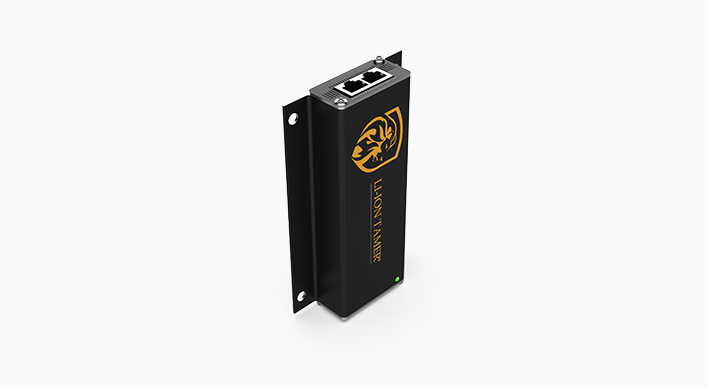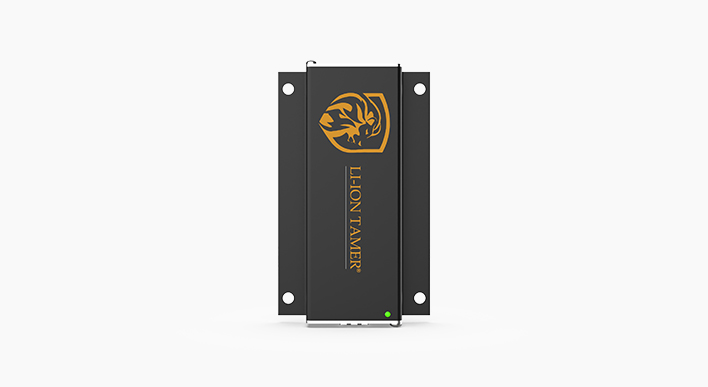Key Features
- Early warning of lithium-ion battery failures
- Extended product lifetime
- Calibration-free
- Compatible with all lithium-ion battery form factors and chemistries
- Easy installation
Overview
The Li-ion Tamer GEN 3 detects the venting of battery electrolyte solvent vapours that occurs during the off-gassing phase of lithium-ion battery failure. By detecting potential fires during this stage, the threat can be investigated and the proper mitigation steps can be taken to avoid catastrophic thermal runaway.
The Li-ion Tamer GEN 3 system consists of several components: monitoring sensors, referencing sensors, hubs, power switches, network switches and at least one Li-ion Tamer Controller.
The daisy-chain connection of the sensors connects at the hub for the purposes of power distribution and CAN bus communications. There are two types of hubs and their use depends on the overall system size and architecture. Each hub can accept a maximum of 12 sensors, regardless of the type of sensor. Each hub comes with a terminator(s), which is required for operation of the sensor daisy-chain. The terminator is a simple RJ45 plug that terminates the end of the CAN bus.
Li-ion Tamer Hub, Direct Power
The Li-ion Tamer Hub Direct Power can be powered with the same 12V DC power supply as the controller and is, therefore, primarily used for small systems.
Li-ion Tamer Hub, PoE
The Li-ion Tamer Hub, PoE is primarily used for larger systems since multiple hubs can be powered using an Ethernet switch, PoE. Using this type of hub requires a PoE Ethernet switch, which requires a 48 VDC power supply; therefore, its use is only recommended in situations where it may be difficult to provide 12V DC power to each hub.
Daisy-Chain Architecture
The daisy-chain CAN bus communication architecture that involves the sensors, hubs and terminators simplifies the installation by reducing cable material and routing. The type of hub that is in use will affect how power is supplied to the daisy-chain and how many chains can be connected.
Li-ion Tamer Hub, Direct Power
With the Li-ion Tamer Hub, Direct Power, a chain of sensors is connected to the Chain A port, and a terminator is attached to the final sensor. The hub receives power through a 12 VDC terminal block, which is positioned on the same side of the hub as the input for the sensor chain. The hub’s output port, situated at the opposite end of the hub, is used to connect either an Ethernet switch or controller.
Li-ion Tamer Hub, PoE
With the Li-ion Tamer Hub, PoE, sensor chains can be connected to either the Chain A port, Chain B port or both, with a terminator connected to the last sensor of each chain. Sensor quantities can be split in any way between Chain A and Chain B but cannot exceed 12 total sensors per hub. The hub output port is located on the hub’s opposite end and connects to, and is powered by, an Ethernet switch, PoE.
Turntable
Approvals




Tech Specs
| Sensors | 12 Maximum |
| Input Voltage | 12 Vdc |
| Power Consumption | Li-ion Tamer Hub, Direct Power:6W @ 12 Vdc |
| Operating Temperature | 0 to 40°C |
| Operating Humidity | 0 to 90% RH (non-condensing) |
| Dimensions (W x H x D) | 149.06mm x 26.36mm x 88.14mm |
Downloads
- Li-ion Tamer Gen 3 Datasheet
- Li-ion Tamer Gen 3 Brochure
- Li-ion Tamer Gen 3 Frequently Asked Questions
Buy

Eurofyre is an authorised distributor of Honeywell and has been a major technical wholesaler of Xtralis products since 2007. We offer expert advice and supply all aspects of Li-ion Tamer lithium ion detection systems including excellent before and after-sale support.
Contact us to receive competitive trade discounts or apply online for a credit account.


